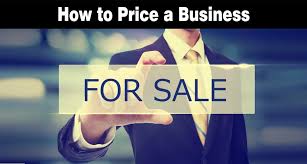Selling a business can be both an exciting and challenging process. One of the most crucial steps in preparing your business for sale is determining its price. Setting the right price is essential to attract potential buyers while ensuring you receive a fair value for your years of hard work. However, pricing a business isn’t as simple as picking a number from thin air. It requires careful analysis, understanding market conditions, and applying different valuation methods to ensure that you set a competitive and realistic price.
In this article, we’ll walk you through the various steps to effectively determine how to price a business for sale.
1. Understand the Importance of Business Valuation
Pricing a business for sale requires you to understand the value of your company from both a financial and market perspective. The right price will reflect not only the tangible assets (like equipment, real estate, and inventory) but also intangible assets (such as intellectual property, brand recognition, and customer relationships).
Additionally, a business’s overall profitability, growth potential, and industry health play significant roles in its valuation. Setting the right price can help you attract more buyers, while an overpriced business may deter potential interest, leaving you with an unsold asset.
2. Evaluate Your Financials
The first step in determining how to price a business for sale is to look closely at your company’s financial health. Financial statements like balance sheets, income statements, and cash flow projections are key to understanding the worth of your business.
Here are the financial factors to consider:
- Revenue and Profit Trends: A steady stream of revenue and increasing profits will justify a higher asking price. If your business has been experiencing growth, that can be a selling point for buyers.
- Debt and Liabilities: The amount of debt your business carries impacts its sale price. If your business has significant liabilities, potential buyers may be hesitant, which could lower your asking price.
- Assets: The value of physical assets (property, equipment, inventory) and intangible assets (intellectual property, trademarks, brand equity) should be included in your valuation.
A strong financial record will help you support your asking price with concrete data, making it easier to justify your business’s value to potential buyers.
3. Choose the Right Business Valuation Method
There are several methods used to value a business, and choosing the right one depends on the nature of your business and the industry it operates in. Here are the most common approaches to consider:
a. Asset-Based Valuation
This method values your business based on the sum of its assets, including both tangible and intangible assets. You subtract the business’s liabilities from the total value of its assets to arrive at a net asset value. This method is often used for businesses with significant assets, such as real estate or manufacturing companies.
b. Income-Based Valuation
An income-based approach focuses on the business’s ability to generate income. One common method in this category is the Discounted Cash Flow (DCF) analysis. DCF takes the projected future cash flows of the business and discounts them to present value, accounting for time and risk.
Alternatively, Seller’s Discretionary Earnings (SDE) is a method often used for small businesses. SDE is calculated by adding back certain owner benefits and non-recurring expenses to the business’s net income. This approach gives potential buyers insight into the business’s cash flow, which can be used to support the asking price.
c. Market-Based Valuation
This approach compares your business to similar businesses that have recently sold in the same industry or market. These businesses should ideally share similar characteristics, such as revenue size, market share, and geographic location. By comparing these sales, you can gauge a reasonable price range for your own business.
The advantage of this approach is that it is market-driven, so it’s closely tied to what buyers are willing to pay in the current market.
4. Consider Industry Standards and Market Conditions
The industry in which your business operates plays a crucial role in how to price a business for sale. Some industries have high multiples of earnings, while others have lower multiples, which will influence your price.
Researching market trends and understanding the health of your industry is essential to ensure that your business’s price is competitive. For instance, businesses in a growing or high-demand industry can command a higher price compared to those in a declining or saturated market.
It’s also important to consider the timing of your sale. The market conditions (such as interest rates, economic cycles, or recent mergers and acquisitions) can influence the value of your business. For example, a business might be worth more when the market is favorable and the demand for acquisitions is high.
5. Factor in Goodwill and Intangibles
Goodwill refers to the reputation, customer loyalty, and brand recognition that your business has built over time. These intangible factors can significantly affect how to price a business for sale.
While difficult to quantify, a strong brand or loyal customer base can be a valuable asset to a buyer. If your business relies heavily on customer relationships or intellectual property, it’s essential to incorporate this goodwill into your valuation.
6. Seek Professional Assistance
Pricing a business for sale is a complex task that requires expertise in finance, accounting, and business valuation. While it’s possible to perform a self-valuation, many business owners choose to hire professionals to help determine an accurate price.
A professional business appraiser, accountant, or business broker can provide an objective perspective, offer advice on market conditions, and help you avoid common pricing mistakes. They can also assist in structuring the sale and negotiating with potential buyers.
7. Adjust for Buyer Perception
Even if your business is worth a certain amount on paper, it’s essential to consider how buyers perceive that value. Buyers will look for value in areas like business efficiency, scalability, and future growth potential. Ensure that your business is presented in the best possible light, and be prepared to justify your asking price.
Conclusion
Pricing a business for sale requires thorough preparation, understanding of financials, and knowledge of the market. By following the steps outlined in this article, you can effectively assess your business’s worth and set a price that reflects its true value. Whether you use asset-based, income-based, or market-based valuation methods, it’s important to ensure that your price is realistic and appealing to potential buyers. Taking the time to price your business correctly can make all the difference in securing a successful sale and achieving the best financial outcome for your future.




